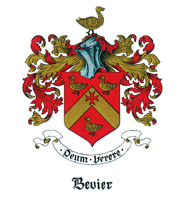Bevier-Elting Family Association
The Bevier-Elting House
The Bevier-Elting House is located on Huguenot Street in New Paltz, NY. Believed to have been built in 1694-1696 by Louis Bevier, this stone house has large windows, a side porch, and a long well-sweep. The house is of the "Netherlands Townhouse" design, and some of the original beams are believed to have come from a Dutch Barn. It became the Elting homestead in 1760.
Bevier Family History
All research to date has failed to uncover the ancestry of Louis Bevier. This is not uncommon in the study of New Paltz patentees. The records which may have at one time existed were either destroyed by fire by officials in France during the Huguenot persecutions, or else members of the families themselves chose to eliminate all evidence of their ties with France.
There is evidence of a family of Beviers twenty miles from Speyer, in the German Palatinate, in 1664. It is possible that this was the same group of Beviers, as we know that Louis married his wife, Marie LeBlanc, in Speyer in 1673.
Louis may have joined the group of patentees in the summer of 1677; he and his wife and family settled in New Paltz with the others in 1678. They may have built a log cabin until the stone and lumber had been gathered to build a more permanent structure. The last five of their eight children were born during the first years of the settlement. Louis’ wife Marie died before the stone house was completed, leaving him with five sons and a daughter. In 1714, Louis was taxed at 350 pounds, the largest amount on the New Paltz tax list.
His son Louis married the daughter of Jean Hasbrouck, the patentee. The couple moved to Marbletown and lived in the house incorporated into the Bevier House, now used as the headquarters of the Ulster County Historical Society. His sons Jean and Abraham also removed to Wawarsing and Marbletown while his daughter Esther maintained the household for her father and her brother Andries, who was described as "simple." When Esther married in 1714 she made a home for Andries as well. Her brother Samuel and his family moved into the homestead to live with their father.
Louis the patentee died in 1720. He left the house to his son Samuel, saying in his will that "he has moved and come to dwell with me." He is said to have been buried in the churchyard on Huguenot Street beside his wife Marie. A memorial stone now marks the place where he is thought to have been buried.
Elting Family History
Although there were no Eltings among the twelve Patentees, the Elting family was an important one in the story of New Paltz. In almost any one of the original families one finds a connection with the Dutch Eltings.
Jan Elting came to America in 1657. By 1665 he owned land on Long Island. When the British took over the colony he was unable to cultivate his land and chose instead to travel north. He was a carpenter by trade and in 1672 married Jacomijntje Cornelisdr Slecht in Kingston. He was later one of the witnesses to the signing of the agreement with the Native Americans in 1677 for the New Paltz patent. He moved to Hurley, near Kingston, where he became a prosperous farmer.
In the early 1700s Roelif Elting came to New Paltz. He was the eldest son of Jan Elting and is described as having come to town "with a belt of gold about his waist." He married Sarah, the daughter of patentee Abraham DuBois, in 1703. His brother Cornelius married her cousin Rebecca.
Roelif and Sarah had seven children. Their son Josiah Elting purchased the Bevier homestead from the children of Samuel Bevier in 1760. Josiah was named as the most affluent man in New Paltz on the 1765 tax list. He was also one of the most liberal subscribers to the Conferentia Church which believed that Dutch Reformed Churches in this country should be subordinate to the Classis of North Amsterdam. The Consistory of the New Paltz Church held that they were not under allegiance to the ecclesiastical power of any foreign country.
Josiah’s son Roelif J. Elting married Mary Louw, the daughter of Rebecca Freer and Johannes M. Louw. The couple lived in the Bevier-Elting house during the Revolutionary War. It was their son Ezekiel who built the "1799 House" on Huguenot Street, now known as the LeFevre House. This house is of stone with a brick front and stucco simulating brick on the south facade. It originally had a hipped roof which was replaced after the blizzard of 1888.
Click here to join the Bevier-Elting family association.



